[English] 日本語
 Yorodumi
Yorodumi- PDB-1cit: DNA-BINDING MECHANISM OF THE MONOMERIC ORPHAN NUCLEAR RECEPTOR NGFI-B -
+ Open data
Open data
- Basic information
Basic information
| Entry | Database: PDB / ID: 1cit | ||||||
|---|---|---|---|---|---|---|---|
| Title | DNA-BINDING MECHANISM OF THE MONOMERIC ORPHAN NUCLEAR RECEPTOR NGFI-B | ||||||
 Components Components |
| ||||||
 Keywords Keywords | TRANSCRIPTION/DNA / ORPHAN NUCLEAR RECEPTOR / EARLY IMMEDIATE RESPONSE GENE PRODUCT / TRANSCRIPTION FACTOR / MONOMERIC PROTEIN-DNA COMPLEX / MINOR GROOVE INTERACTIONS / PROTEIN/DNA / TRANSCRIPTION-DNA COMPLEX | ||||||
| Function / homology |  Function and homology information Function and homology informationneurotransmitter secretion involved in regulation of skeletal muscle contraction / AKT phosphorylates targets in the nucleus / cellular response to corticotropin-releasing hormone stimulus / regulation of type B pancreatic cell proliferation / non-canonical inflammasome complex assembly / detection of lipopolysaccharide / Nuclear Receptor transcription pathway / endothelial cell chemotaxis / nuclear glucocorticoid receptor binding / cell migration involved in sprouting angiogenesis ...neurotransmitter secretion involved in regulation of skeletal muscle contraction / AKT phosphorylates targets in the nucleus / cellular response to corticotropin-releasing hormone stimulus / regulation of type B pancreatic cell proliferation / non-canonical inflammasome complex assembly / detection of lipopolysaccharide / Nuclear Receptor transcription pathway / endothelial cell chemotaxis / nuclear glucocorticoid receptor binding / cell migration involved in sprouting angiogenesis / transcription factor binding / fat cell differentiation / negative regulation of cell cycle / skeletal muscle cell differentiation / response to electrical stimulus / cellular response to vascular endothelial growth factor stimulus / cellular response to fibroblast growth factor stimulus / positive regulation of endothelial cell proliferation / response to amphetamine / lipopolysaccharide binding / nuclear receptor activity / sequence-specific double-stranded DNA binding / presynapse / double-stranded DNA binding / DNA-binding transcription activator activity, RNA polymerase II-specific / response to lipopolysaccharide / transcription regulator complex / sequence-specific DNA binding / transcription by RNA polymerase II / DNA-binding transcription factor activity, RNA polymerase II-specific / positive regulation of apoptotic process / RNA polymerase II cis-regulatory region sequence-specific DNA binding / inflammatory response / protein heterodimerization activity / apoptotic process / regulation of transcription by RNA polymerase II / chromatin / positive regulation of DNA-templated transcription / positive regulation of transcription by RNA polymerase II / mitochondrion / DNA binding / zinc ion binding / identical protein binding / nucleus / cytosol Similarity search - Function | ||||||
| Biological species |  | ||||||
| Method |  X-RAY DIFFRACTION / X-RAY DIFFRACTION /  SYNCHROTRON / SYNCHROTRON /  MOLECULAR REPLACEMENT / Resolution: 2.7 Å MOLECULAR REPLACEMENT / Resolution: 2.7 Å | ||||||
 Authors Authors | Meinke, G. / Sigler, P.B. | ||||||
 Citation Citation |  Journal: Nat.Struct.Biol. / Year: 1999 Journal: Nat.Struct.Biol. / Year: 1999Title: DNA-binding mechanism of the monomeric orphan nuclear receptor NGFI-B. Authors: Meinke, G. / Sigler, P.B. | ||||||
| History |
|
- Structure visualization
Structure visualization
| Structure viewer | Molecule:  Molmil Molmil Jmol/JSmol Jmol/JSmol |
|---|
- Downloads & links
Downloads & links
- Download
Download
| PDBx/mmCIF format |  1cit.cif.gz 1cit.cif.gz | 51.7 KB | Display |  PDBx/mmCIF format PDBx/mmCIF format |
|---|---|---|---|---|
| PDB format |  pdb1cit.ent.gz pdb1cit.ent.gz | 32.9 KB | Display |  PDB format PDB format |
| PDBx/mmJSON format |  1cit.json.gz 1cit.json.gz | Tree view |  PDBx/mmJSON format PDBx/mmJSON format | |
| Others |  Other downloads Other downloads |
-Validation report
| Summary document |  1cit_validation.pdf.gz 1cit_validation.pdf.gz | 437 KB | Display |  wwPDB validaton report wwPDB validaton report |
|---|---|---|---|---|
| Full document |  1cit_full_validation.pdf.gz 1cit_full_validation.pdf.gz | 441.3 KB | Display | |
| Data in XML |  1cit_validation.xml.gz 1cit_validation.xml.gz | 7.7 KB | Display | |
| Data in CIF |  1cit_validation.cif.gz 1cit_validation.cif.gz | 9.7 KB | Display | |
| Arichive directory |  https://data.pdbj.org/pub/pdb/validation_reports/ci/1cit https://data.pdbj.org/pub/pdb/validation_reports/ci/1cit ftp://data.pdbj.org/pub/pdb/validation_reports/ci/1cit ftp://data.pdbj.org/pub/pdb/validation_reports/ci/1cit | HTTPS FTP |
-Related structure data
| Related structure data |  1hcqS S: Starting model for refinement |
|---|---|
| Similar structure data |
- Links
Links
- Assembly
Assembly
| Deposited unit | 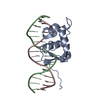
| ||||||||
|---|---|---|---|---|---|---|---|---|---|
| 1 |
| ||||||||
| Unit cell |
|
- Components
Components
| #1: DNA chain | Mass: 4932.218 Da / Num. of mol.: 1 / Source method: obtained synthetically | ||
|---|---|---|---|
| #2: DNA chain | Mass: 4865.152 Da / Num. of mol.: 1 / Source method: obtained synthetically | ||
| #3: Protein | Mass: 10098.962 Da / Num. of mol.: 1 / Fragment: DNA-BINDING DOMAIN AND C-TERMINAL EXTENSION Source method: isolated from a genetically manipulated source Source: (gene. exp.)   | ||
| #4: Chemical | | #5: Water | ChemComp-HOH / | |
-Experimental details
-Experiment
| Experiment | Method:  X-RAY DIFFRACTION / Number of used crystals: 1 X-RAY DIFFRACTION / Number of used crystals: 1 |
|---|
- Sample preparation
Sample preparation
| Crystal | Density Matthews: 2.4 Å3/Da / Density % sol: 53 % | ||||||||||||||||||||||||||||||||||||||||||||||||||||||
|---|---|---|---|---|---|---|---|---|---|---|---|---|---|---|---|---|---|---|---|---|---|---|---|---|---|---|---|---|---|---|---|---|---|---|---|---|---|---|---|---|---|---|---|---|---|---|---|---|---|---|---|---|---|---|---|
| Crystal grow | pH: 7 Details: PROTEIN/DNA COMPLEX CRYSTALS WERE GROWN USING THE VAPOR DIFFUSION METHOD AT 27 DEGREES CELSIUS. THE RESEVOIR CONTAINS 50 MM MORPHOLINO-SULFONIC ACID PH7.0, 250MM AMMONIUM CHLORIDE, 30 % PEG ...Details: PROTEIN/DNA COMPLEX CRYSTALS WERE GROWN USING THE VAPOR DIFFUSION METHOD AT 27 DEGREES CELSIUS. THE RESEVOIR CONTAINS 50 MM MORPHOLINO-SULFONIC ACID PH7.0, 250MM AMMONIUM CHLORIDE, 30 % PEG 4000, 5 MM DTT. THE DROPS CONTAINED A 1:1 RATIO OF PROTEIN-COMPLEX TO RESEVOIR. | ||||||||||||||||||||||||||||||||||||||||||||||||||||||
| Crystal grow | *PLUS Temperature: 27 ℃ / pH: 7.5 / Method: vapor diffusion, hanging dropDetails: drop consists of 1:1 mixture of well and protein solutions | ||||||||||||||||||||||||||||||||||||||||||||||||||||||
| Components of the solutions | *PLUS
|
-Data collection
| Diffraction | Mean temperature: 100 K |
|---|---|
| Diffraction source | Source:  SYNCHROTRON / Site: SYNCHROTRON / Site:  NSLS NSLS  / Beamline: X12B / Wavelength: 0.98 / Beamline: X12B / Wavelength: 0.98 |
| Detector | Type: MARRESEARCH / Detector: IMAGE PLATE / Details: MIRROR |
| Radiation | Protocol: SINGLE WAVELENGTH / Monochromatic (M) / Laue (L): M / Scattering type: x-ray |
| Radiation wavelength | Wavelength: 0.98 Å / Relative weight: 1 |
| Reflection | Resolution: 2.7→18 Å / Num. obs: 5200 / % possible obs: 95 % / Observed criterion σ(I): 3 / Redundancy: 2.3 % / Biso Wilson estimate: 80.3 Å2 / Rsym value: 0.073 / Net I/σ(I): 14.5 |
| Reflection shell | Resolution: 2.7→2.8 Å / Mean I/σ(I) obs: 3.1 / Rsym value: 0.368 / % possible all: 96.9 |
| Reflection | *PLUS Rmerge(I) obs: 0.073 |
| Reflection shell | *PLUS % possible obs: 96.9 % / Rmerge(I) obs: 0.368 |
- Processing
Processing
| Software |
| ||||||||||||||||||||||||||||||||||||||||||||||||||||||||||||||||||||||||||||||||
|---|---|---|---|---|---|---|---|---|---|---|---|---|---|---|---|---|---|---|---|---|---|---|---|---|---|---|---|---|---|---|---|---|---|---|---|---|---|---|---|---|---|---|---|---|---|---|---|---|---|---|---|---|---|---|---|---|---|---|---|---|---|---|---|---|---|---|---|---|---|---|---|---|---|---|---|---|---|---|---|---|---|
| Refinement | Method to determine structure:  MOLECULAR REPLACEMENT MOLECULAR REPLACEMENTStarting model: PDB ENTRY 1HCQ Resolution: 2.7→18 Å / Rfactor Rfree error: 0.012 / Data cutoff high rms absF: 401381.9 / Isotropic thermal model: RESTRAINED / Cross valid method: THROUGHOUT / σ(F): 0 / Details: BULK SOLVENT MODEL USED
| ||||||||||||||||||||||||||||||||||||||||||||||||||||||||||||||||||||||||||||||||
| Solvent computation | Solvent model: FLAT MODEL / Bsol: 27 Å2 / ksol: 0.29 e/Å3 | ||||||||||||||||||||||||||||||||||||||||||||||||||||||||||||||||||||||||||||||||
| Displacement parameters | Biso mean: 32.8 Å2
| ||||||||||||||||||||||||||||||||||||||||||||||||||||||||||||||||||||||||||||||||
| Refine analyze |
| ||||||||||||||||||||||||||||||||||||||||||||||||||||||||||||||||||||||||||||||||
| Refinement step | Cycle: LAST / Resolution: 2.7→18 Å
| ||||||||||||||||||||||||||||||||||||||||||||||||||||||||||||||||||||||||||||||||
| Refine LS restraints |
| ||||||||||||||||||||||||||||||||||||||||||||||||||||||||||||||||||||||||||||||||
| LS refinement shell | Resolution: 2.7→2.87 Å / Rfactor Rfree error: 0.04 / Total num. of bins used: 6
| ||||||||||||||||||||||||||||||||||||||||||||||||||||||||||||||||||||||||||||||||
| Xplor file |
| ||||||||||||||||||||||||||||||||||||||||||||||||||||||||||||||||||||||||||||||||
| Software | *PLUS Name: CNS / Version: 0.5 / Classification: refinement | ||||||||||||||||||||||||||||||||||||||||||||||||||||||||||||||||||||||||||||||||
| Refine LS restraints | *PLUS
|
 Movie
Movie Controller
Controller


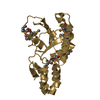
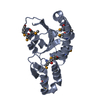

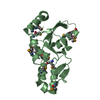
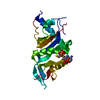




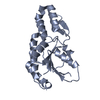
 PDBj
PDBj









































